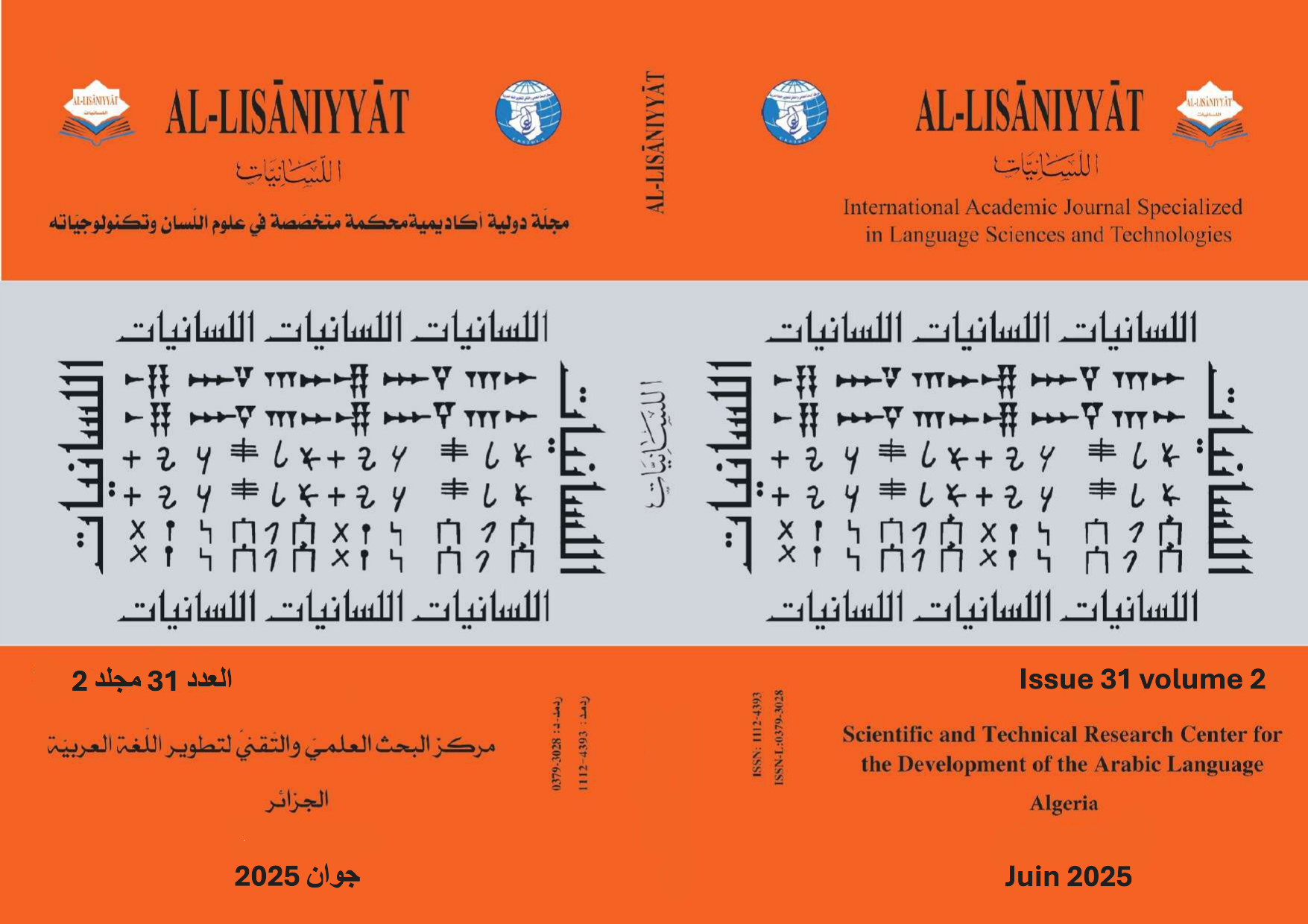Approach of Grammatical Justification in Al-Khalil Ibn Ahmad Al-Farahidi "Semantic Explanation as a Model"
Main Article Content
Abstract
The Arabs adopted grammatical justification from the time of Al-Khalil (100H – 170H), and all grammatical schools focused on identifying the underlying causes (ʿilla) governing the Arabic language. Among these scholars, Al-Khalil Ibn Ahmad Al-Farahidi played a central role, and his disciple Sibawayh faithfully transmitted what he had learned from him. Al-Khalil was distinguished by his deep mastery of the concept of justification, his extensive knowledge, and his interest in exploring its various forms. For him, the issue was not merely about listening to linguistic examples and testimonies but about conducting a systematic investigation that enabled him to rigorously establish grammatical and morphological rules, as evidenced by the work of his disciple Sibawayh.
Al-Khalil thus paved the way for identifying and extracting grammatical justifications, relying on his exceptional genius, his understanding of the purposes of Arabic speech, his mastery of linguistic styles, and his knowledge of Arabic aesthetics—what was considered elegant or displeasing in speech. His disciple’s work attests to the breadth and richness of his explanations, granting him a special status in establishing the foundations of grammatical justification in Arabic. Through this study, we examine his methodology in linguistic justification, focusing on semantic explanation as a model of study in Al-Khalil’s work and exploring its key characteristics that influenced the structuring of Arabic grammar.
Article Details

This work is licensed under a Creative Commons Attribution-NonCommercial 4.0 International License.
References
2 ــــ ابن الأنباري (1976). نزهة الأنباء في طبقات الأدباء. إبراهيم السامرائي(محرر). بغداد: مكتبة الأندلس
3-عبابنة، جعفر نايف(د.ت). وضع الخليل بن أحمد لأصول النحو البصري وفروعه (رسالة ماجستير، كلية الآداب)، جامعة القاهرة.
4ــــ ابن جني (2008). الخصائص. محمد علي النجار(محرر). القاهرة: دار الكتاب العربي.
5-الجوهري (1973). تاج اللغة وصحاح العربية (ج 5). عبد الغفور عطار(محرر). بيروت: دار العلم للملايين.
6ــ الحديثي، خديجة (1990). المدارس النحوية(ط.2). مطبعة جامعة بغداد.
7-الفراهيدي، الخليل بن أحمد(د.ت). معجم العين (ج 7).
8-الزبيدي (1306ه). تاج العروس من جواهر القاموس. مصر: المطبعة الخيرية.
9 ــــ الزجاجي (1986). الإيضاح في علل النحو(ط.5). مازن المبارك(محرر). بيروت: دار النفائس.
10ــــ زكي، حسام الدين (1984). أصول تراثية في اللسانيات الحديثة (ط. 03).
11-ابن السراج(د.ت). الأصول في النحو (ج 1).
12ــــ سيبويه (1977). الكتاب (ط. 02). عبد السلام هارون(محرر). الهيئة العربية العامة للكتاب.
13ـــ السيوطي (1987). المزهر في علوم اللغة وأنواعها. مولى حاج الحق(محرر). بيروت: المكتبة العصرية.
14-ضيف، شوقي (د.ت). المدارس النحوية. مصر: دار المعارف.
15ـــــ المبارك، مازن (1965). العلة النحوية، نشأتها وتطورها. المكتبة الحديثة.
16-محمد الحلواني (1983). أصول النحو العربي. الرباط: الأطلسي.
17ــــ حماسة، محمد عبد اللطيف (2015). مدخل لدراسة المعنى النحوي الدلالي (ط 02). القاهرة: دار غريب للطباعة.
18-ابن منظور (1994). لسان العرب(ج11)، (ط03). بيروت: دار صادر.
19ــــــــ عيد، محمد (2006). أصول النحو العربي. القاهرة: عالم الكتب.
20-منى إلياس (1985). القياس في النحو. الجزائر: ديوان المطبوعات الجامعية.
21ــــــ مهدي المخزومي (1986). الخليل بن أحمد أعماله ومنهجه. بيروت: دار الرائد العربي.
22-ابن الوراق (2008). علل النحو (ط 02). محمود نصار(محرر). بيروت: دار الكتب العلمية.
References
1. Ibrahim, Anis (1976). Turuq Tanmiyat al-Alfaz fi al-Lugha. Cairo.
2. Ibn al-Anbari (1976). Nuzhat al-Anba’ fi Tabaqat al-Adaba’. Ibrahim al-Samarra’i (Ed.). Baghdad: Maktabat al-Andalus.
3. ‘Ababneh, Ja‘far Nayif (n.d.). Wad‘ al-Khalil bin Ahmad li-Usul al-Nahw al-Basri wa-Furu‘ih (Master’s thesis, Faculty of Arts), Cairo University.
4. Ibn Jinni (2008). Al-Khasa’is. Muhammad Ali al-Najjar (Ed.). Cairo: Dar al-Kitab al-‘Arabi.
5. Al-Jawhari (1973). Taj al-Lugha wa-Sihah al-‘Arabiyya (Vol. 5). ‘Abd al-Ghaffur ‘Attar (Ed.). Beirut: Dar al-‘Ilm li-l-Malayin.
6. Al-Hadithi, Khadija (1990). Al-Madaris al-Nahwiyya (2nd ed.). Baghdad University Press.
7. Al-Farahidi, Khalil bin Ahmad (n.d.). Mu‘jam al-‘Ayn (Vol. 7).
8. Al-Zabidi (1306 AH). Taj al-‘Arus min Jawahir al-Qamus. Egypt: Al-Matba‘a al-Khayriyya.
9. Al-Zajjaji (1986). Al-Idah fi ‘Ilal al-Nahw (5th ed.). Mazin al-Mubarak (Ed.). Beirut: Dar al-Nafa’is.
10. Zaki, Hossam al-Din (1984). Usul Turathiyya fi al-Lisaniyyat al-Haditha (3rd ed.).
11. Ibn al-Sarraj (n.d.). Al-Usul fi al-Nahw (Vol. 1).
12. Sibawayh (1977). Al-Kitab (2nd ed.). ‘Abd al-Salam Harun (Ed.). The Arab General Authority for Books.
13. Al-Suyuti (1987). Al-Muzhir fi ‘Ulum al-Lugha wa-Anwa‘iha. Mawla Haj al-Haqq (Ed.). Beirut: Al-Maktaba al-‘Asriyya.
14. Dayf, Shawqi (n.d.). Al-Madaris al-Nahwiyya. Egypt: Dar al-Ma‘arif.
15. Al-Mubarak, Mazin (1965). Al-‘Ilal al-Nahwiyya: Nash’atuha wa-Tatawwuruha. Al-Maktaba al-Haditha.
16. Muhammad al-Halawani (1983). Usul al-Nahw al-‘Arabi. Rabat: Al-Atlasi.
17. Hamasa, Muhammad ‘Abd al-Latif (2015). Madkhal li-Dirasat al-Ma‘na al-Nahwi al-Dalali (2nd ed.). Cairo: Dar Gharib li-Tiba‘a.
18. Ibn Manzur (1994). Lisan al-‘Arab (Vol. 11), (3rd ed.). Beirut: Dar Sadir.
19. ‘Eid, Muhammad (2006). Usul al-Nahw al-‘Arabi. Cairo: ‘Alam al-Kutub.
20. Mona Ilyas (1985). Al-Qiyas fi al-Nahw. Algeria: Diwan al-Matbu‘at al-Jami‘iyya.
21. Mahdi al-Makhzoumi (1986). Al-Khalil bin Ahmad: A‘maluhu wa-Manhajuhu. Beirut: Dar al-Ra’id al-‘Arabi.
22. Ibn al-Warraq (2008). ‘Ilal al-Nahw (2nd ed.). Mahmoud Nassar (Ed.). Beirut: Dar al-Kutub al-‘Ilmiyya.
